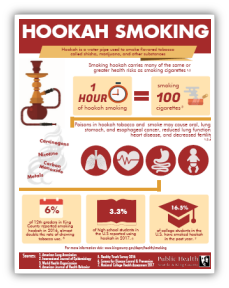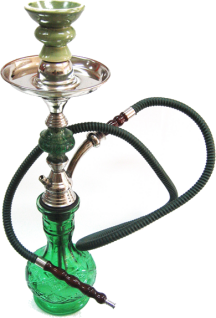Hookah smoking
Hookah is a water pipe used to smoke tobacco, marijuana and other substances. Smoke is created through indirect charcoal heat, filtered through water, and drawn through a rubber hose to a mouthpiece. It is often smoked in group settings using the same mouthpiece.1 Shisha, a mixture of tobacco and a sweetener (such as molasses) is a commonly-used product for hookah in the U.S. and is often flavored to taste like fruit or candy.
Not a safe alternative to cigarettes
- Many hookah smokers believe that smoking hookah is less harmful than smoking cigarettes.2 However, smoking tobacco from a hookah carries many of the same or greater health risks as smoking cigarettes.1,5
- Water pipe smoking delivers nicotine, which is addicting, and is at least as toxic as cigarette smoke.3
- Due to the frequency of puffing, depth of inhalation, and length of the smoking session, hookah smokers may absorb higher concentrations of the toxins found in cigarette smoke.1,5
- A typical 1-hour-long hookah smoking session involves inhaling over 100 times the volume of smoke inhaled from a single cigarette.4
- Hookah smokers may be at risk for some of the same diseases as cigarette smokers, such as oral lung, stomach and esophageal cancer, reduced lung function and decreased fertility.5,6
High use among youth and young adults
- In King County, 4% of 12th graders reported using hookah within the last 30 days7
- Almost a quarter of U.S. young adults (aged 18-24) had used hookah to smoke flavored tobacco.8
Health effects of hookah smoking and secondhand smoke
- The charcoal used to heat tobacco in the hookah increases the health risks by producing high levels of carbon monoxide, metals, and cancer-causing chemicals.1,6
- Hookah tobacco and smoke contain numerous toxic substances known to cause lung, bladder, oral cancers, and heart disease.1,6
- Secondhand smoke from hookahs poses a serious risk, particularly because it contains smoke not only from the tobacco but also from the heat source (e.g., charcoal) used in the hookah.1,6
- Babies born to women who smoked one or more water pipes a day during pregnancy have lower birth weights than babies born to nonsmokers and are at an increased risk for respiratory diseases.9
- Infectious diseases may be transmitted between smokers due to sharing a hookah.5
New forms of hookah
In recent years, new forms of hookah smoking have been introduced.
- Studies of tobacco-based shisha and "herbal" shisha show that smoke from both preparations contains carbon monoxide and other toxic agents known to increase the risks for smoking-related cancers, heart disease, and lung disease.13,10
- Electronic hookah, such as steam stones and hookah pens, are battery powered and turn liquid containing nicotine, flavorings, and other chemicals into a vapor, which is inhaled.11 Products that contain nicotine are addictive, yet very little information is currently available on the health risks of the other flavorings and chemicals.
- For more information about electronic devices (e-cigarettes, vaping devices) see our E-cigarette and vapor product page.
Regulations
Hookah smoking is regulated the same way cigarette smoking is in Washington. State law and local King County Board of Health Code prohibit smoking (including hookah smoking) from all public places and places of employment. There are no exemptions for traditional hookah lounges.
References
1 American Lung Association. An Emerging Deadly Trend: Waterpipe Tobacco Use Washington: American Lung Association, 2007.
2 Aljarrah K, Ababneh ZQ, Al-Delaimy WK. Perceptions of hookah smoking harmfulness: predictors and characteristics among current hookah users. Tob Induc Dis 2009;5(1):16.
3 Knishkowy, B., Amitai, Y. Water-Pipe (Narghile) Smoking: An Emerging Health Risk Behavior . Pediatrics. 2005;116:113–119. Accessed 2009 April 21.
4 World Health Organization. Tobacco Regulation Advisory Note. Water Pipe Tobacco Smoking: Health Effects, Research Needs and Recommended Actions by Regulators. (PDF–550 KB) Geneva: World Health Organization, Tobacco Free Initiative, 2005. Accessed 2015 Oct 16.
5 Akl EA, Gaddam S, Gunukula SK, Honeine R, Jaoude PA, Irani J. The Effects of Waterpipe Tobacco Smoking on Health Outcomes: A Systematic Review. International Journal of Epidemiology 2010;39:834–57. Accessed 2015 Sept 14.
6 Cobb CO, Ward KD, Maziak W, Shihadeh AL, Eissenberg T. Waterpipe Tobacco Smoking: An Emerging Health Crisis in the United States. American Journal of Health Behavior 2010;34(3):275–85. Accessed 2015 Sept 14.
7 2018 Washington Healthy Youth Survey.
8 Truth Initiative, "Correlates of Hookah Use and Predictors of Hookah Trial in U.S. Young Adults" American Journal of Preventive Medicine
9 Nuwayhid, I, Yamout, B., Ghassan, and Kambria, M. Narghile (Hubble-Bubble) Smoking, Low Birth Weight and Other Pregnancy Outcomes. American Journal of Epidemiology 1998;148:375–83. Accessed 2011 Feb 15.
10 Blank MD, Cobb CO, Kilgalen B, Austin J, Weaver MF, Shihadeh A, Eissenberg T. Acute Effects of Waterpipe Tobacco Smoking: A Double-Blind, Placebo-Control Study. Drug and Alcohol Dependence 2011;116(1–3):102–9. Cited 2015 Sep 14.
11 U.S. Food and Drug Administration. Electronic Cigarettes (e-Cigarettes). Last updated 2013 April 25; accessed 2015 Sep 14.

 Translate
Translate

